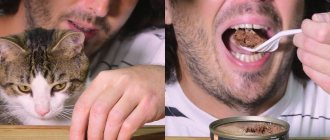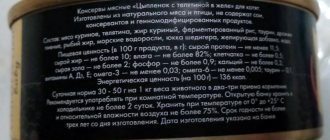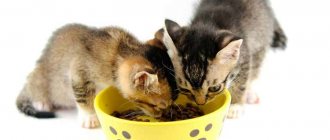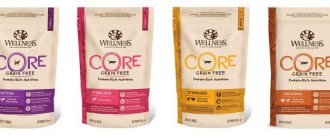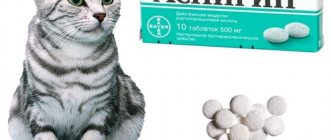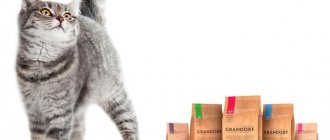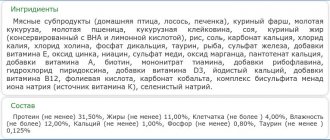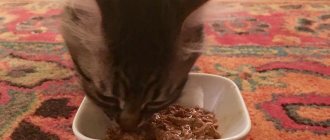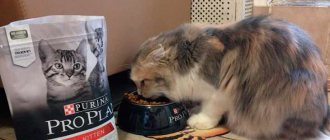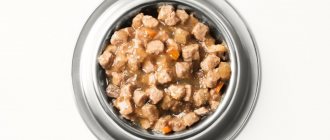After breastfeeding ends, the responsibility for feeding the furry pet is transferred to the owner. For full growth and development, a kitten requires not only nutrients, but also vitamins to strengthen the bone structure. Any mistake is fraught with health problems and even the death of a fragile pet. The owner will have to understand the nuances of different types of nutrition, recommended modes and portion sizes.
Nutritional features of a two-month-old kitten
The first complementary foods are given after 4 weeks, when the first teeth begin to emerge. The diet can be based on dry or natural food, depending on the characteristics of the pet and the wishes of the owner.
By breed
All cats are carnivores, so their diet should include meat and sufficient protein. Veterinarians recommend starting from life in the wild. A fishing cat is a rare occurrence, but milking a cow independently is a completely phenomenal case. Therefore, fish and dairy products are not as necessary for cats as poultry or animal meat.
There is no strict division by breed. The feeding rules are the same for everyone, but can be adjusted depending on the breed characteristics:
- Maine Coons
. "Manx raccoons" are distinguished by their large dimensions. They require much more food than other breeds. Maine Coons have a hard time digesting food, so they are fed small but frequent portions. With this approach, the stomach does not have time to be overloaded, and the body receives the necessary energy.
- British and Scots
. Thick-cheeked and lop-eared handsome men are prone to obesity. These short-haired pets need to be fed high-protein, low-carbohydrate meals. If your weight jumps above normal, it is recommended to reduce calorie intake by reducing portions or replacing foods.
- Sphinxes
. Hairless cats are voracious and always hungry, but are less likely to gain weight. Most of what they eat goes to warm their naked body. Babies up to 4 months are fed 6 times a day, gradually moving to 2 meals a day by 1 year. The daily intake for an adult cat is 5% of its weight.
It is recommended that you check with the breeder or veterinarian for nutritional details regarding the selected breed. Don't forget to monitor your weight and reaction to new foods. This will help avoid secondary diseases arising from obesity and aggravation of food allergies.
By frequency of meals
Some cats are born without a sense of satiety. Focusing on a hungry gaze is pointless and dangerous. Such animals eat until they vomit and quickly gain weight, suffering from diseases of the musculoskeletal system, urolithiasis and other pathologies.
To prevent unpleasant consequences, use a strict regimen that takes into account the frequency of meals and the amount of food for different ages. It is best to discuss recommendations regarding serving sizes with your veterinarian. This depends on the breed and growth rate, so the indicator is calculated individually.
Up to 1 month, food is offered not only during the day, but also at night. Feeding a kitten at 2 months already excludes night hours - it is enough to serve food 6-7 times during the day. Animals older than 1 year are fed twice.
By diet composition
A two-month-old pet has all its milk teeth, so its diet is enriched with more solid food. Puree-like meat, ground with vegetables, is replaced with small boiled pieces. Continue cooking the grains until they become watery, providing enough liquid.
When offering new dishes, monitor your baby's reaction. The appearance of diarrhea, vomiting, rashes and other alarming signs is a serious reason to exclude certain foods. Also start from the taste of your furry pet. Do not allow prolonged fasting - if you refuse the offered dishes, always look for alternative ones.
Transition from mother's milk to solid foods
If your baby is left without breast milk before reaching two months of age, take care of him yourself. As a safe replacement, veterinarians recommend using powdered milk formulas sold in pet stores and veterinary pharmacies. Homemade mixtures, including cow's milk, granulated sugar, yeast and egg, are acceptable only as a temporary option. They are inferior to ready-made mixtures due to their lower nutritional value and highly allergenic properties.
The transition to solid food begins at 1 month. You can feed your pet:
- liquid porridges (semolina, rice);
- light meat broths without salt;
- finely chopped boiled lean meat;
- natural fermented milk products with low fat content.
1-2 times a week, offer boiled egg yolk or boiled sea fish, cleaned of bones. Introduce the listed products gradually and monitor the body’s reaction.
During feedings, make sure that your little pet does not fall into the food bowl. Left alone, he may choke.
Natural and ready-made food: can they be mixed?
Many owners, preferring dry food, sometimes feed their pet with natural food, for example, meat or vegetable dishes. At the same time, they are confident that a piece of cutlet or the dog’s favorite slice of cheese will not cause harm to the animal’s body.
But is this really so and is it possible to feed a dog by mixing natural and dry food in one plate?
Experts have a unanimous opinion on this matter: the dog’s nutrition should be separate. And if natural food is chosen as feeding, then it is absolutely forbidden to mix it with dry granules!
Natural food cannot be mixed with dry food.
The thing is that natural and dry food are digested at different intervals . Food from ordinary products begins to move into the intestines within forty minutes after entering the stomach and is completely poisoned within two hours.
Dry granules
But dry granules only begin to swell in the stomach after forty minutes, so their digestion takes much more time - from three to five hours.
Thus, if you mix dry food with porridge or vegetables, then in forty minutes the overcooked porridge will enter the dog’s intestines, and along with it the non-poisoned granules, which will rot in the large intestine .
But this does not mean that when feeding dry food, you cannot pamper your dog with his favorite dish made from natural products. Occasionally, you can feed your pet boiled meat or cottage cheese, while following one rule: do not give the dog natural food earlier than five hours after the main meal.
Occasionally, you can give your dog cottage cheese.
Top dressing
The same applies to feeding dry granules, which can be given to the dog two hours after eating.
If a pet sometimes begs its beloved owner for a piece of meat or a cookie, this will not cause irreparable harm to its health. But it is strictly forbidden to mix two types of food, otherwise, due to such carelessness of the owner, the dog will pay with problems with the digestive system.
A piece of cookie after eating will not harm the dog.
Menu made from natural ingredients
Supporters of “natural food” emphasize its naturalness and safety for the cat’s body. Despite this statement, natural products have their drawbacks: not all of them are equally healthy and harmless.
Advantages and disadvantages
The main advantage is the ability to independently select ingredients. This eliminates the presence of artificial colors and preservatives. Also among the advantages it is worth noting:
- menu variety;
- the ability to replace one dish with another without harm to the body;
- absence of dependence and addiction.
The disadvantages of “natural” food lie in the difficulty of regularly preparing fresh dishes and complying with the recommended consumption of vitamin and mineral complexes. Such food requires a lot of free time and is sometimes more expensive than dry food.
Required Products
The diet is based on meat, offal, dairy products, cereals and vegetables. Due to the danger of infection by parasites, offal is given only in boiled form twice a week. I also boil chicken breast, turkey, veal or other lean meats, and 60% of the diet should come from protein products.
Once a week, the meat is replaced with sea fish, cleaned of bones. It is enriched with phosphorus, which improves wool quality. Eating fish too often can lead to loss of vitamin K and the development of urolithiasis due to excess protein.
Prepare healthy dishes based on grated zucchini, beets, carrots and herbs, adding small pieces of meat to them. Offer 1 teaspoon three to four times a week. vegetable oil from olive or flax. Once a week, add the boiled yolk of a chicken or quail egg to the porridge - it normalizes digestion.
Natural cottage cheese and low-fat sour cream are available sources of calcium. They strengthen bones and saturate the body with vitamins.
Prohibited Products
Another disadvantage of “natural” is the presence of prohibited products. These include:
- bones that can damage the esophagus or block the supply of oxygen;
- fatty meat and lard that overload the liver;
- mushrooms, eggplants, garlic, legumes, potatoes, tomatoes and onions;
- any seasonings;
- raw egg whites and chicken skin;
- whole milk, which causes digestive problems due to lactose intolerance;
- canned, smoked, fried or other dishes from the human table;
- sweets and baked goods considered toxic to animals;
- river fish containing the most dangerous parasites.
Lactose problems are more common in older animals, but sometimes occur earlier. Observe the kitten after he has treated himself to milk.
Feeding sick and elderly dogs
Of course you can feed your dog dry food. The main thing is to choose a quality product, check the integrity of the packaging, expiration date, and individual tolerance. The granules should be eaten with pleasure by the dog, not cause allergies, digestive disorders and meet the needs of the animal, which can only be judged after a certain time has passed.
Dry food is economical and convenient
Which food is better
Ideally, this should be super-premium or holistic food. They contain meat, grains, fruits and vegetables, probiotics, and the necessary complex of vitamins and minerals. Natural preservatives are used in production. Despite the higher cost, the consumption of high-quality feed is less. Premium foods contain low quality ingredients, but some of them are indeed animal products.
Contain preservatives, large amounts of cereals, flour, soy and other ballast substances. Economy class food is made from low quality ingredients, usually food waste, soy, corn flour, which is not digested at all. Their composition is often poor in vitamins and microelements, and they also contain harmful flavor enhancers and flavorings.
Almost all advertised food belongs to the economy class, the differences of which are described above. Conclusion: don’t believe advertising. When choosing food, you should also not rely only on the relative protein/fat ratio, which is so often discussed on forums. For example, a product with the following indicators: protein – 35%; fat – 25% (which will be confirmed by an independent laboratory analysis) can be prepared from:
- 1 leather shoe;
- 1 feather pillow;
- 1 kg sawdust.
- 1 l. recycled motor oil;
It is not the percentage of protein that is important, but the indication of its origin. Any food has a composition, and the shorter it is, the better. Products are arranged in descending order. In the first place there should be meat, 1-2 types. If “lamb fillet” or “fresh kangaroo meat” is indicated - 35%, we remove moisture from it and in fact it turns out - 7%. Top of the list should be hydrated meat or meat meal with identified protein (chicken, lamb, rabbit, etc.).
chopped, ground flakes, hydrolyzed vegetable protein, gluten. By-products should be no higher than position 5. The food must contain oil (sunflower, flaxseed, salmon) or fat. A good plus will be the presence of sea fish meal, dried berries, herbs (rosemary, chicory, alfalfa), pre- and probiotics, as well as a competent selection of vitamins and microelements.
- Holistics: Akana, Artemis, Canidi, Chicken Soup, Go, Grandorf, Innova, Original, Test of the Wild, Wellness, Almo Nature.
- Super-premium: Almo Necher, Artemis, Eagle Pak, Arden Grange, Fest Choice, Pronature Holistic, Bosch, Belcando, Nutra Gold.
- Premium class: Anf, Brit Care, Diamond, Eukanuba, Happy Dog, Hills, Nutra Dog, Yozera, Yoral Canin, Pronature, Original, Advance, Bozita, Brit Premium, Nutra Nuggets, Purina Pro Plan, Purina Dog Chow.
- Economy class: Chappie, Darling, Pedigree, ARO.
We suggest you read: How to choose a Labrador puppy and how to care for him
Food should best suit the physiological needs of the dog: age (puppy, junior, adult dog, elderly), size (dwarf, small, medium, large, giant), activity (domestic, active ) and health status. Diets have been developed for healthy animals and dogs with various problems, but they can only be given after consultation with your doctor. Flavoring additives can be any: with fish, meat, chicken, the main thing is that the dog likes them.
The duration of feeding one diet is an individual matter. First of all, it depends on the age of the dog. For example, they switch from a junior diet to an adult diet at the age of about a year, and to food for older animals at the age of 8-9 years. However, it is also important to take into account the condition of the animal. It happens that a ten-year-old Spitz is much more active and energetic than a five-year-old Pekingese, then it makes sense to keep him on a “youth” diet longer.
An equally important question is: how much should you feed your dog? The daily portion is calculated by weight, based on the recommendations indicated on the packaging. But you can slightly adjust it, reduce it, or, on the contrary, increase it a little if there is a clear lack of weight on your face (or rather, on your muzzle).
https://www.youtube.com/watch?v=ytabout
Pros:
- No need to cook;
- Convenience (you can take dry food with you on a trip);
- Economic benefits (even high-class food is usually cheaper than a full diet of natural products). In addition, there is no need to spend extra money on vitamin and mineral supplements.
Minuses:
- Cheap feeds have minimal nutritional value;
- If the storage rules and integrity of the packaging are not followed, the food may deteriorate and cause poisoning of varying degrees of severity;
In the first week, puppies suckle their mother at least 12 times a day. At week 2 - 8, by week 4 - 6 times and before weaning 4-5 times. For artificial feeding, it is more convenient to use ready-made substitutes for bitch milk. If this is not possible, the mixture can be prepared independently using whole cow, goat or sheep milk.
There is no need to dilute it; its composition is already inferior to that of bitches. To add more nutritional value to 100 grams of whole cow's milk, add a chicken egg yolk, a teaspoon of cream, a tablespoon of 40% glucose, 3 drops of ascorbic acid and 1-2 drops of trivitamin. From 3 weeks they begin to give milk semolina porridge and water. At 4 weeks, meat broth and calcined cottage cheese are introduced. From 6 weeks, minced meat, eggs in the form of an omelet, from 1.5 months, vegetables in the form of puree.
The total weight of puppy food is calculated based on body weight.
- Up to 6 months - approximately 7%.
- From 6 to 12 months, the volume of food is adjusted to 3-4% of the weight.
We suggest you read: Diarrhea in newborn puppies treatment
Up to 3 months, the puppy’s diet consists of 40-50% dairy products, 40% is allocated to meat, fish, and the rest vegetables and cereals. After 3 months, the ratio changes in favor of meat products: 50-70% meat and offal, dairy products 20-30%, the rest cereals and vegetables.
In sick and elderly dogs, the metabolic rate decreases. The animal becomes less mobile, peristalsis slows down. It is important to prevent the development of obesity, which will further aggravate existing problems and create new ones. The amount of fats and carbohydrates should be reduced, while the amount of vegetables is increased in order to improve motor skills, and fasting days are introduced. If there are problems with teeth, transfer the animal to soft food.
The nutrition of sick dogs deserves special attention. If an animal suffers from urolithiasis, the diet is adjusted depending on the type of stones. If you have kidney disease, reduce the amount of protein. For cardiac problems, a low sodium diet is recommended. In any case, the veterinarian must adjust the diet based on the dog’s condition, diagnosis and expediency.
Dwarf dogs require food richer in proteins compared to large breeds; they are often susceptible to early tooth loss, so sweets are strictly excluded. It is recommended to feed them in small portions at least 3 times a day, even for adults. In this case, the main diet is given not at night, but at noon.
For those prone to obesity, it is advisable to divide the daily intake into 4 doses. Vegetables are given in the form of puree, meat can be ground into minced meat. The daily ration for medium and large dogs is fed in two doses, with the evening meal being the main one. Once a week it is useful to have a fasting day. The meat is cut into pieces, and the vegetables are grated on a coarse grater.
There are no perfect foods or feeds. What suits one dog may not suit another. A complete diet is one in which the animal does not change body weight and does not show signs of metabolic disturbances, appetite, reproductive function or basic health indicators.
Dry and wet food
In addition to classic dry food, you can use wet canned food. Together they compensate for each other's shortcomings: 75% of the diet is allocated to dry food, and 25% to wet food. This also has its own nuances, so before deciding what food to feed a 2-month-old kitten, compare the advantages and disadvantages of each method.
Advantages and disadvantages
Most of the disadvantages lie in low-quality economy class products. It is prepared from low-quality raw materials (bones, fats, skins, feathers) with an abundance of mineral salts, preservatives and flavorings. These ingredients have a detrimental effect on the cat’s body, provoking the development of urolithiasis.
If an allergy or other disease occurs that requires a change in food, it takes quite a long time (8-10 days) to mix new granules with the old ones in order to make a smooth transition. Abrupt transitions are excluded, as they can provoke gastrointestinal upset.
Safe and healthy products include premium, super-premium and holistic classes. Their advantages are:
- an abundance of different lines developed for individual breeds, as well as taking into account age characteristics and the presence of diseases;
- saving time on cooking;
- availability of daily allowances on each package;
- balance of composition;
- prevention of tartar and strengthening of the jaw muscles.
Dry granules take up little space, making them easier to take when traveling. It is easier to leave an animal with this type of food for foster care with relatives or friends. Even an elderly person with limited mobility can feed your pet.
Variety of food for kittens
When purchasing a furry family member through a breeder, check in advance what to feed your two-month-old baby. If the seller has already started feeding him a specific brand, then stick to the same brand for up to a year.
The most expensive granules and wet canned food belong to the holistic class. Despite their prestige, they are not suitable for animals with problems with the urinary system.
The best brands of kibble and canned food that have a line for kittens include:
- Hill's;
- Orijen;
- Happy Cat Junior;
- 1st Choice;
- Eukanuba;
- Royal Canin;
- ProNature;
- Purina ProPlan;
- Acana;
- Go Natural.
Wet canned food is served to your pet only when heated. Be sure to put any uneaten pieces in the refrigerator until the next feeding.
How to choose?
Avoid stores that sell pellets by weight. Once the package is opened, the shelf life is reduced. The quality of such a product is often questionable.
When choosing a brand, consider the manufacturer. Products from Russian factories are significantly inferior in quality. The safest producing country is Canada. Some Canadian food can even be eaten by humans.
Be sure to consult your veterinarian before purchasing. If there are diseases, he will offer a veterinary line.
Remember that you cannot save on ready-made food; eating budget brands will lead to the same problems as eating fast food.
Mixed nutrition
The owner will have to decide in advance what to feed the kitten at 2 months and adhere to the chosen type of food. It is not recommended to mix both types of feeding: it is forbidden to give the kitten dry food in the morning, and meat and porridge in the evening. This can lead to an excess of vitamins or pathologies of the gastrointestinal tract (gastroenteritis, intestinal obstruction).
If the owner needs to transfer the baby from one type of feeding to another, it is necessary to make the transition as smooth as possible. In the case of a two-month-old kitten, it is better to consult a veterinarian - at least by phone.
Natural nutrition
For 1 kg of dog weight you need 15-25 g of meat. Thus, an adult dog weighing 15 kg should receive 225-375 g of meat per day. The nutritional value of fish and meat is approximately the same; if meat is replaced by offal, then they should be given approximately one and a half times more.
An acceptable diet in percentage terms is as follows:
- 30-50% meat, offal or fish;
- 25-35% cereal;
- 20-30% fermented milk products;
- 10-15% vegetables and fruits.
However, ideally, the diet should contain more meat and dairy products:
- 50-70% meat, offal or fish;
- 30-40% fermented milk products;
- 10-20% vegetables and fruits;
- 10-15% coarse.
A little sunflower oil (1-2 drops per kilogram of weight) and fish oil are added to food daily, and raw or boiled eggs are fed 2-3 times a week. Vitamin and mineral supplements are given during the period of active growth and subsequently in the off-season. Puppies of large and giant breeds are also required to be fed chondroitin, glucosamine, calcium and fat-soluble vitamins for the normal development of the musculoskeletal system. During seasonal molting, complexes for skin and coat are recommended.
Natural nutrition - confidence in the quality of products
Meat (beef, poultry, rabbit) should contain some amount of cartilage, tendons, and fat. Lamb is too fatty for many dogs and causes digestive upset. Pork is not recommended to be fed raw due to its fat content and the likelihood of parasites, which are destroyed during heat treatment.
It is better to feed fish raw. When feeding only raw fish, hypovitaminosis B1 develops, but for a homemade mixed diet this problem is not relevant. Fish is given instead of meat 2-3 times a week. Fillet of sea or ocean fish is suitable; river fillet must be frozen or boiled, which will avoid infection with helminths.
Dairy products in the form of cottage cheese, yogurt, kefir, sour cream 10-15% fat. Most dogs cannot digest whole milk. You can add a little honey to dairy products and beat in an egg. From time to time it is useful to cook calcined cottage cheese for your dog. It is not necessary to give milk every day. However, on those days when it is absent, it is necessary to increase the amount of meat and offal. Dairy and meat products are not mixed in one feeding.
The grains are cooked in bone broth. Rice and buckwheat are best; sometimes you can give barley and oatmeal. You should not cook corn, pearl barley, or legume porridge, which are difficult to digest.
We suggest you read: When do kittens’ eyes open and how many days will it take for them to start seeing?
It is better to feed vegetables raw; suitable: carrots, cucumbers, white cabbage, peppers, zucchini, pumpkin, beets. If the vegetables are not easily eaten, you can lightly stew them. Be sure to add greens, and in summer also herbs (nettle, dandelion, knotweed).
Every owner should know what not to feed their dog:
- Exclusively meat and protein products - puts a lot of strain on the kidneys;
- Bones have no nutritional value and can lead to constipation and damage the gastrointestinal tract;
- Poor quality products can cause poisoning of varying severity;
- Sweets cause allergic reactions, burden the liver, provoke obesity and the development of diabetes;
- Fatty, fried foods burden the liver and pancreas;
- Salty food provokes salt deposits, joint problems, and electrolyte imbalance;
- Spicy food irritates the gastric mucosa, which can lead to gastritis and ulcers;
- Raw river fish and pork can be infected with helminths;
- Cat food high in protein and fat can lead to kidney failure;
- Legumes, products made from wheat flour and heavy cereals increase gas formation in the intestines, and in large breeds they can cause gastric volvulus.
Pros:
- Confidence that the dog is receiving quality products.
- Ability to independently adjust your diet.
Minuses:
- As a rule, it is more expensive than dry food and requires regular administration of vitamins and minerals
- The need to cook regularly and take up space in the refrigerator.
Feeding regimen and portion size
Two-month-old kittens are fed 6 times a day. The baby should eat 160-180 g of natural products per day. Standards for dry granules, taking into account the weight of the animal, are indicated on the packaging.
Divide your daily intake into 6 equal portions or make 3 smaller portions and use them as snacks. Until six months, the pet is actively developing, gaining muscle mass. It is important to maintain a balance here: avoid overfeeding or starvation. Weigh your baby weekly to monitor changes in his weight.
General rules
For the full development of a little pet, the owner will have to follow a number of rules. These include:
- Use only fresh and warm food. Do not store food for more than a day and be sure to warm it to room temperature before serving. The shelf life of wet canned food should not exceed 2 days.
- Mandatory division of the daily norm into several doses. Don't try to offer everything at once and put the bowl away after finishing feeding.
- Regular washing of dishes. Pathogenic microorganisms grow quickly in food bowls. Wash them after each feeding and try to use ceramic or iron products.
- A ban on any methods of heat treatment of food other than boiling.
Additional attention will have to be paid to the drinking regime and vitamins. It is best to discuss the last question with your veterinarian.
Do I need additional vitamins?
Ready-made food already contains all the necessary vitamins, so only those who eat natural food will need additional supplements. A growing body needs vitamins A, B, C, D, E and K, as well as minerals (calcium, iron, phosphorus, magnesium, selenium). Their deficiency is fraught with weak immunity, deterioration of the coat, softening of bones and teeth, impaired blood clotting and other complications.
It is important to consider the danger of not only a lack, but also an excess of vitamins. Independent selection of vitamin and mineral complexes can lead to hypervitaminosis. The brand name, dosage and duration of use should be checked with your veterinarian. The most commonly prescribed are Gimpet, Excel, Canina and Hartz.
Drinking regime
As you transition to solid foods, you will need more liquid, so purchase a separate bowl for water. Do not pour it from the tap without first cleaning it. Sediments contained in tap water are dangerous for your little pet. Also, do not forget about hygiene - wash the bowl and change the water in it daily.
If your pet eats dry granules, pay special attention to the drinking regime. Lack of fluid provokes salt deposition, which can lead to the formation of stones and blockage of the urinary ducts. If your water consumption is low, give it from a syringe or experiment with containers. Most picky cats will accept the owner's mug, large bucket-like container, or drinking fountain.
Proper and balanced nutrition is the basis of strong immunity and health. Compliance with the listed nuances and recommendations will protect your pet from a number of diseases and allow him to grow into an attractive cat.
The article is for informational purposes only. Contact your veterinarian!
